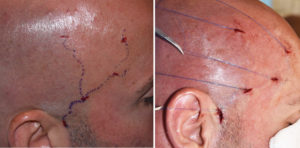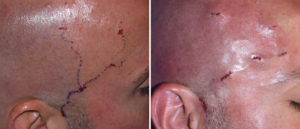The development of visible temporal arteries in the forehead is not rare. Occurring almost exclusively in men, the frontal or anterior branch of the superficial temporal artery becomes dilated and its course up into the forehead becomes prominent. Often occurring after exercise, heat exposure or alcohol intake, the muscular walls if the artery dilate makes its course very visible. In some patients the size of the artery may decrease but in other patients it may persist for days. While this is largely as aesthetic issue, some patients complain of associated headaches and even visual blurring.
Temporal artery ligation is the surgical treatment for such aesthetic forehead vessel dilatations. It should be not confused, however, with the ligation technique done for temporal arteritis or temporal artery biopsy. While that procedure does ligate (and remove a section) of the vessel, its intent is not to stop the flow through the artery. It is to remove a section of the vessel for pathologic analysis. Any blood flow reduction is an inadvertent side effect.
But aesthetic temporal artery ligation is done with the intent of ceasing flow through the prominent section of the artery. If flood is diminished or eliminated it will no longer be visible. While it may seem like ligating the vessel before it ever enters the non-hair bearing temporal and forehead areas should work, it often by itself does not. This only treats one part of the problem, inflow or anterograde flow. It does not account for back flow or retrograde flow which comes from the cross-connections across the scalp.


Dr. Barry Eppley
Indianapolis, Indiana


